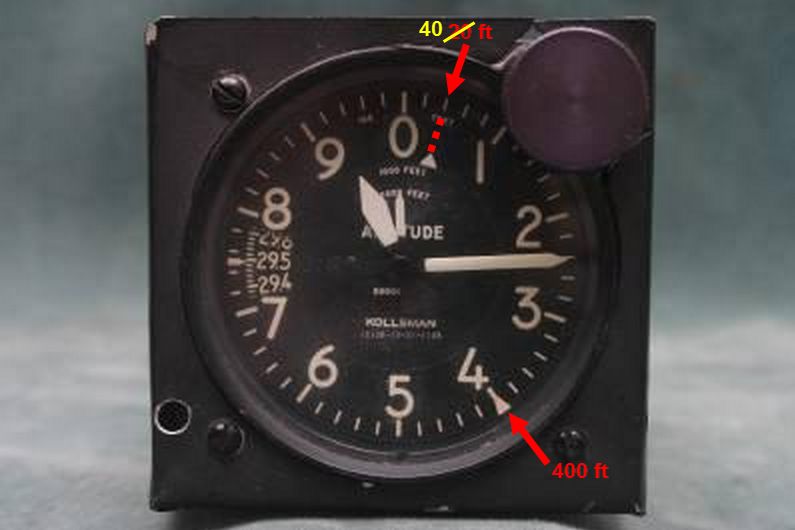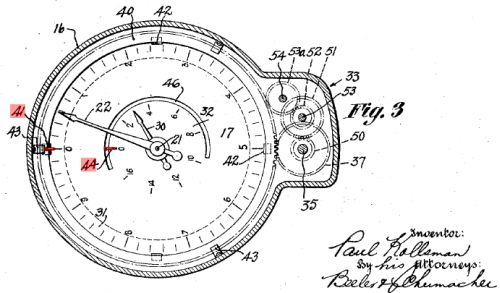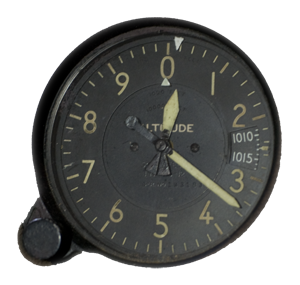kgruber
Final Approach
Is there anyone here who is old enough to remember why the old VOR/ILS indicators had blue and yellow markings.

I remember "We're in the blue!"
I remember "We're in the blue!"
Is there anyone here who is old enough to remember why the old VOR/ILS indicators had blue and yellow markings.

I remember "We're in the blue!"

Is there anyone here who is old enough to remember why the old VOR/ILS indicators had blue and yellow markings.

I remember "We're in the blue!"
Is there anyone here who is old enough to remember why the old VOR/ILS indicators had blue and yellow markings.
Now, can you tell me the names of the various L/F range station orientations?
View attachment 38068
And the two little extra triangular pointers on this altimeter are for... what, exactly?
dtuuri
Ok, I'm only givin' y'all one more chance to hijack this thread. I know some of ya still have this kind of altimeter and are puzzled by the function of the triangles, er, I think you are anyways. And there must be somebody who actually knows!
dtuuri

Ok, I'm only givin' y'all one more chance to hijack this thread. I know some of ya still have this kind of altimeter and are puzzled by the function of the triangles, er, I think you are anyways. And there must be somebody who actually knows!
dtuuri

Here's a guess---
It looks like the little triangles are telling you the altitude difference between a standard day (29.92” Hg) and the pressure actually dialed into the altimeter’s window (29.5” Hg), i.e. 29.92" -29.5", or 0.42” Hg. Converted to altitude, that’s 420 feet.
The inward facing triangle is pointing at 4 (hundreds of feet) and the outward facing triangle is pointing at 2 (tens of feet).
The pressure altitude is 420 feet off of the indicated altitude, or vice versa.
Like this?:

I was thinking the same thing, but that arrow at the top is pointing to 40 feet, not 20.
See discussion of "reference markers" here. (Also called "reference marks" there.)
As I understand it, you set the little guys to QFE and your altimeter should read 0 upon landing.
(At the airport, the tower or FBO would set a similar instrument to show 0, and broadcast on the radio the altitude indicated by the reference markers as the "QFE setting", similar to the current way of reading inches of mercury units inside the Kollsman window and setting either "0" (for QFE) or field elevation (for QNH) on the big pointers.)
(Discussion on this thread.)
I'm not sure those references help me understand. I "know" from an old crusty WWII pilot/CFI that the reference marks had everything to do with QFE, but I can't remember what he said (over 40 years ago!). I "think" the triangles go the opposite direction from the hands. I can probably deduce the procedure they used to get QFE if this is right:
Agreed so far? Anybody?
- The picture could be of an altimeter at SL with a local setting supposed to be 30.25.
- If the hands were turned from SL down to pressure altitude of 29.92, then the triangles would show zero.
- If the hands were turned further to where they are in the photo (below SL), the triangles would go the other way up to where they are shown.
dtuuri
An important use of the instrument occurs when the aviator desires to descend for landing. He then obtains, as by radio message, shortly before landing, the barometric pressure at the landing field expressed in feet altitude, and sets the reference mark accordingly. Assume that the altitude corresponding to the barometric pressure at the landing field is 300 feet. Then the reference mark 41 may move counterclockwise, to the scale numeral 7, and the pointers including pointer 22 may move counterclockwise. The pointer then will indicate the altitude above the field and will read zero when landing. The aviator is thus assured of an accurate landing guide, especially under conditions of poor visibility as in fog or at night.

Here's an explanation straight from the inventor's mouth. According to Paul Kollsman’s 1931 reissue patent no. RE18306 (page 4, lines 110-127):

I don't pretend to know, but here is another for sale.
http://www.ebay.com/itm/WW2-Kollsman-50K-feet-Sensitive-Aircraft-Altimeter-Rebuilt-Calibrated-C10A-/171671506300

My suspicion is that this unit has been tampered with, since the Kollsman setting indicates "220 feet" low, while the little pointers are reading -870 feet.
The big hands reading is irrelevant, since it depends on the current pressure.
The other unit, OTOH, seems pretty much dead on.
Here is some complicated explanation.
http://www.brisbanehotairballooning.com.au/calculating-pressure-and-density-height/

I dunno, it fits my logic so far. I haven't yet studied the above references and posts, but while I'm at it, here's one from January 1948 Flying Mag.
dtuuri
IIRC the markers get set to field elevation and will line up as QFE when QNH is set in the window rather than having the needles at zero with a QFE setting.

The little pointers read -135 feet, no?My suspicion is that this unit has been tampered with, since the Kollsman setting indicates "220 feet" low, while the little pointers are reading -870 feet.
Here's some insight as to how the altimeters were set to "field pressure" using the Kollsman window to read QFE. Before takeoff, I guess they simply set the altimeter hands to zero and read the "field pressure altitude" off the reference triangles as "xxx feet above/below" the standard datum of 29.92 and cross-checked it with the station manager's result via radio. If it was deemed airworthy, before landing they'd get a new field pressure altitude reading from the destination manager. Sound reasonable?
1.17 Other InformationThis was from the crash report of Eastern Flight #212 on 9/11/74 at Charlotte.
The following are excerpts from Eastern Air Lines' manual:
"Eastern A i r Lines DC-9 Flight Operations Procedures - A l t i m-
-e t e r s (upper) and a No. 2 (lower) for the captain and a No. 1 for the f i r s t officer. Altimeters on standard EAL installations are a No. 1 "An altimeter check w i l l be nude at station of origin and a t each crew or aircraft change as follows:
1. No. 1 altimeters, set barometric scale to Field Pressure setting (Kollsman) as reported by ground station; check variation of altitude indication from zero.
2. No. 2 altimeter, set barometric scale to most recently reported sea level altimeter setting for the field; check variation of check variation of altitude indication from field elevation."
dtuuri

Meh. The copy/paste was giving me fits from that old report. Try reading now. It looks like they got the "feet" version for landing as well as millibars (which I suppose they couldn't set?) and then read back the Kollsman reading in inches Hg which the station manager verifed. Ya think?Not sure about the "altimeter check will be nude at station" reference.
The little pointers read -135 feet, no?
dtuuri
Meh. The copy/paste was giving me fits from that old report. Try reading now. It looks like they got the "feet" version for landing as well as millibars (which I suppose they couldn't set?) and then read back the Kollsman reading in inches Hg which the station manager verifed. Ya think?
dtuuri
I dunno, it fits my logic so far. I haven't yet studied the above references and posts, but while I'm at it, here's one from January 1948 Flying Mag.
dtuuri
What a great article.
It was a bit tough to jump around in that viewer, so in case anybody else wants to read it with less effort, here's a link to download it as one combined PDF:
http://goo.gl/Ua1FCX
Thank you so much for that!I'll savor every word later today. I can see where the principles involved may be somewhat lost on pilots these days. This looks like a terrific review. For instance, I had to puzzle out why setting the hands to zero would render ambient pressure. Probably hadn't thought about it in several decades.
dtuuri
What a great article.
It was a bit tough to jump around in that viewer, so in case anybody else wants to read it with less effort, here's a link to download it as one combined PDF:
http://goo.gl/Ua1FCX
